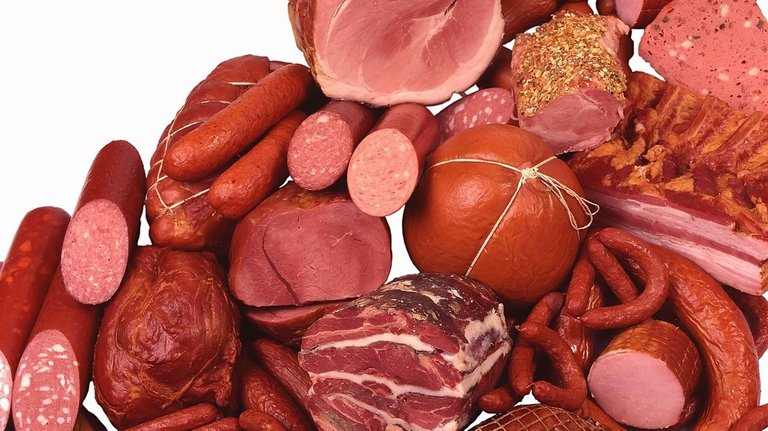
Meat
–Most processed meat are usually made from beef and pork
–Meat from other species eg mutton, chevon or goat meat, poultry and rabbit meat can but are rarely used
–The skeletal muscle is high in the myofibrillar proteins myosin and actomyosin which are salt soluble
–These proteins help to bind water and emulsify fat.
–Their gelling properties ensure proper binding of meat particles to each other
–Meat high in connective determines the colour of the final product but does not have a binding effect on the meat protein
Fat
–Fat content of meat varies with the specie
–the type of meat cut and the carcass grade
–Fat in processed meat affects
–the tenderness
–juiciness
–and palatability of the sausage
–The kind and level of saturation of the fat also affect the appearance of the product
–while the specie has effect on the final flavour
–The maximum allowable fat in the cooked sausage is 30%
Water
•Water is added:
•as ice or very cold water during the process of comminution or the sausage batter
•It dissolves salt, nitrite and other soluble ingredients for easy distribution during emulsification
•It makes the final product more tender and juicy
Salt
•Food grade salt is the only acceptable salt to avoid off flavour and off colour in cured meat
•It diffuses into muscle fibres by osmotic action causing them to swell
•It gives an ionic strength of 0.8 to 1.0 at
5% salt with no water added to the meat
•In comminuted meat, it extracts myofibrillar protein making them available for stable emulsion formation
•It gives desirable flavour
•It has preservative effect against bacteria at high concentration through osmotic action and by dehydration
•It inhibits many enzymes
•It varies in processed meat from 1 to 8% but averages 2% in bacon, 3% in hams and about 1% for ordinary flavour development
•It can be rubbed on the outside of large portions in dry curing but takes a long time to penetrate
•It is also injected in form of brine or sweet pickle for uniform distribution
•Straight salt solution is brine or pickle
•When sugar is added, it becomes sweet pickle
Sugar
•It is added to processed meat for flavour development
•When used with salt in sweet pickle or in dry curing;
•it removes the hardening and harshness encountered when salt alone is used
•It provides proper medium or growth of desirable fermenting bacteria in long cured ham and in dry and semi dry sausages
•Creates reducing condition for conversion of nitrates to nitrites
•Examples are sucrose as cane or beet sugar, and other saccharine, glucose,
•lactose when non fat dry milk (NFDM) is used, brown sugar, mapple and raisin syrups
•honey, corn sugar/syrup/syrup solids
•Brown sugar and the syrups are less desirable as they cause dark colour on frying the meat
•It is applied at 2 to 3kg per 100 liters of brine
Nitrate and Nitrite
•Include sodium and potassium salts of nitrate and nitrite
•Can be used individually or mixed
•They enhance formation of the characteristic cured meat colour which has better eye appeal than the grey colour in salt cured ham
•When mixed, the nitrite provides the initial cure and the nitrate the final cure
•Used singly, nitrite provides cure as in cooked sausages and nitrate for long cure as in fermented sausage and country ham
•The nitrate must first be reduced to nitrite by bacterial action
•This is a slow process
Much less nitrate is needed than nitrite.
•Nitrate in high concentration is toxic as excess can be converted to nitrosamine which is carcinogenic
•200 ppm or less of nitrite is permitted in the finished products
•However 50ppm appears insufficient as it results in poor acceptable cured meat colour and aroma
Effectiveness of nitrite is related to
•Time and temperature of curing,
•Amount of protein but especially concentration of myoglobin pigment present,
•Amount of fat and added carbohydrate as sugar,
•Concentration of salt,
•Nitrate and/or nitrite,
•pH and presence of desirable microbes
The nitrite reacts with myoglobin and residual hemoglobin
•Nitrite imparts preservative effects in meat products by inhibiting growth of anaerobic bacteria e.g Clostridium botulinum and other food poisoning and spoilage microbes
Phosphates
•These are complex inorganic compounds including
•Sodium tripolyphosphate
•Sodium hexametaphosphate
•Sodium pyrophosphate
•Tetrasodium pyrophosphate
•Sodium diphosphate
They are added singly or in combination but 0.5% in the finished product.
•With salt, phosphates enhance water binding and fat emulsification ability of salt soluble meat proteins and water retention on cooking thereby increasing yield by reducing cooking loss
•Increase pH and ionic strength thereby improving water holding capacity
•They have buffering effect
•They reduce purge (water and gelatin release on cooking) in canned hams
•May act as cure accelerators
•They improve the uniformity, stability and acceptability of cured meat colour
In conjunction with Vitamin C, they prevent rancidity in cured meat
•They improve tenderness and juiciness of finished products
•As they are corrosive, only stainless steel and plastic curing vats can be used
Cure accelerators
•These are compounds used to accelerate colour development in cured meat products
•Examples are:
•Sodium ascorbate (salt of ascorbic acid or vitamin C)
•Sodium erythorbate (salt of isoascorbic acid)
Uses:
•Hastens reduction time of metmyoglobin to myoglobin from 5hr to 50 mins or less thereby accelerating cured meat colour development and stabilization during heat processing
•Excess ascorbate acts as antioxidant and prevents colour fading in cured meat.
Acidifiers
•Of practical importance in dry and semi-dry sausages
•Presentation derives from low to intermediate moisture content
•Increased salt and acid content
Acidity is developed through fermentation of sugar to lactic acid by use of starter cultures
•lactic acid producing microbes including Lactobacillus plantarlum and Pediococais cerevisiae are commonly used
•Acidifying agents which can be added to processed meat include:
•sodium acid pyrophosphate in frankfurters
•Glucono-delta-lactone in dry sausages
DANGERS OF MEAT ADDITIVES
Gastritis
Colon Cancer
Gastric Byepass
-Stomach Cancer
-Food Poisoning
Upvote, comment ,resteem and follow @iamfranklinn .
Thanks for this message
Thumbs up!